Speaking of Japanese nabe (or hot pot), there are so many types such as Yosenabe, Chanko nabe, Mizutaki, Sukiyaki, Shabu-shabu, Motsu nabe, etc. Each type has its own feature and ingredients. Have you ever heard of “Harihari nabe”? This may sound too cute for a nabe but it is actually a popular Osaka hotpot. Let’s us explain the name of it, its history and where to find delicious restaurants below.
What is Harihari nabe?
Harihari nabe also referred to simply as ‘Harihari,’ is a type of hot pot dish made with whale meat and mizuna (potherb mustard). Because whale meat is difficult to come by these days, many restaurants substitute pork or duck meat and serve a nabe with plenty of mizuna as ‘harihari nabe.’ The whale meat itself tastes like chicken or duck. In Osaka, they often eat this dish and by simmering it in the dashi stock, you can be sure that it doubles the umami. Japanese characterized this by adding chili peppers directly to the pot to give it a spiciness, or by adding sansho (Japanese pepper) or chili peppers as condiments to make it spicier.
Etymology
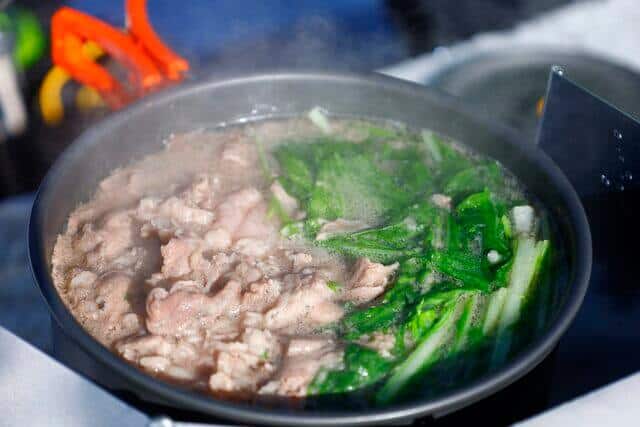
The name “harihari” is onomatopoeic, referring to the sound of mizuna chewing. Locals commonly made the dish with irigara (炒り殻). When whaling was popular in Japan, whale meat was cheap and easy to obtain, and the dish was popular among the general public.
Harihari nabe History

In a hot pot, whale meat, which was once a common ingredient for ordinary people, and mizuna greens, which locals cultivated primarily in the Kansai region for a long time, are cooked. As the meal progresses, the whale broth becomes entwined with the mizuna greens. It started at Tokuya, a whale restaurant in Sennichimae, Osaka, in 1967. It is a traditional winter delicacy popular among the people of Osaka. The name Harihari-nabe derives from the crunching sound made when eating mizuna.
Japanese now considered whale meat a luxury item, but when whaling was popular in Japan, it was one of the cheapest meats available and a common source of protein for the general population. Osaka once had a very active whale market due to its proximity to Taiji, Wakayama Prefecture, which was one of Japan’s leading whaling bases, and a food culture based on whale meat flourished. However, after they banned commercial whaling in the 1980s, it became increasingly difficult to obtain, and it is now increasingly replaced by other meats such as pork (commercial whaling resumed in 2019).
Harihari nabe Recipe

Harihari nabe Ingredients
| Ingredients of Harihari nabe for 4 persons | Measurements |
|---|---|
| Whale meat (red meat)Prepare and boil the water | 400g |
| Mizuna (Kyoto greens) | 800g |
| Water | 1000g |
| Shaved bonito | 60g |
| [Seasoning A] Sake | 227g |
| [Seasoning A] Soy sauce | 120g |
| [Seasoning A] Sugar | 84g |
| [Seasoning A] Mirin | 28g |
| Ginger | 8g |
How to make Harihari nabe
Cut the mizuna into 4-5cm lengths. Bring the water to a boil, add the shaved bonito, and simmer over medium heat for 10 to 15 minutes while removing the scum to make a thick dashi stock.
Bring the boiled and the seasoning (sake, sugar, soy sauce, and mirin) to a boil and add the whale meat.
When it boils, add mizuna. Then, when you know the mizuna is cooked, place it in a small bowl along with the whale meat and dashi stock, add grated ginger and eat hot.
If you like, you can sprinkle shichimi pepper and powdered Japanese pepper.
Typical ingredients for Harihari nabe
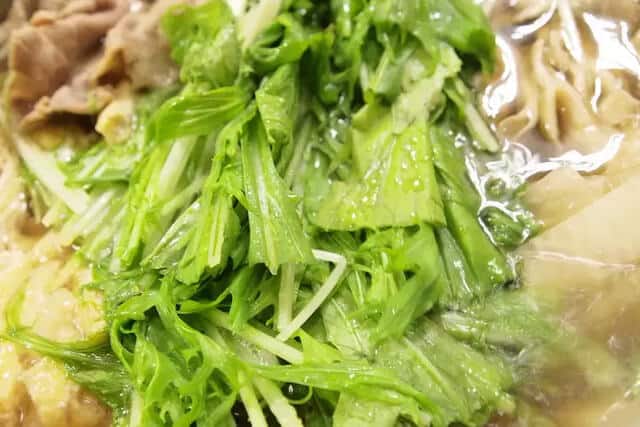
Pork is the main ingredient in the Harihari Nabe, but the must-have supporting role is mizuna. Locals usually add a lot of mizuna to a pot of kombu and dried bonito stock, along with thinly sliced fatty whale meat like tail meat. When it comes to a boil, then add powdered Japanese pepper or shichimi chilli pepper to taste. There is also a method of simmering only the water from mizuna without dashi and seasoning it with soy sauce, sake, sugar, and other ingredients.
What kind of hot pot is Harihari Nabe?
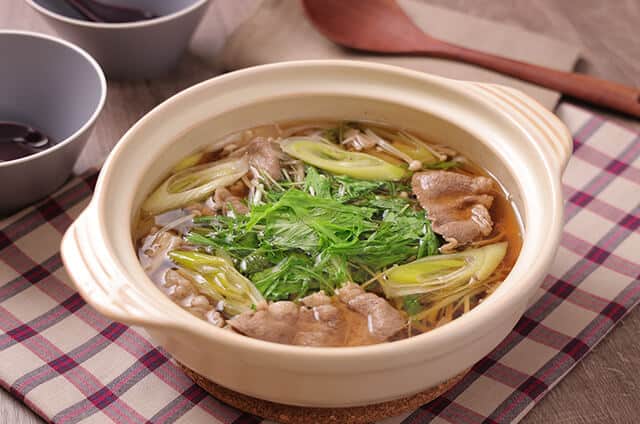
Harihari nabe is a Kansai region nabe with plenty of mizuna greens added to bonito stock with thinly sliced pork. The fat melts into the light bonito-based soup stock, adding depth and richness. A delicious aftertaste is created by the gradual umami of the pork and the crunchy bitterness of the mizuna greens.
When and how to eat Harihari nabe?

It is very popular as a cold season menu because it uses mizuna, which is in season in winter, and it is a hot pot dish that warms the body. Locals add plenty of mizuna, and whale meat. To enjoy the crunchy texture of mizuna, the best time to eat it is when they cooked it quickly. If you like, you can add powdered Japanese pepper or shichimi chili pepper. Ingredients and seasonings vary from home to shop.
Where to buy Harihari nab
Original Kujiraya (元祖 くじら屋)

Founded in 1950, Kujiraya is one of the few restaurants in Tokyo that specializes in whale dishes. A head chef specializing in whale cuisine procures a whole minke whale, a by-product of research whaling. This is a restaurant where you can enjoy the deliciousness of whales, from the flavorful red meat to the fat tongue called “Saezuri” and other rare parts.
Dozono (どおぞの)

The appeal of this restaurant is that you can enjoy not only the Harihari Nabe, but also a full course of various whale dishes. People who see whale meat for the first time may be a little surprised. The color varies greatly depending on the part. The red meat served with the mizuna must be prepared in advance so that the dashi soup is thoroughly soaked in.
Murasaki (むらさき)

The specialty here is “Kujira Harishabu Hot Pot”. You can enjoy whale meat in a style that combines Harihari nabe and shabu-shabu. What is different from the usual “harihari nabe” is that mizuna is wrapped in whale meat for sashimi and dipped in a special broth. The lightly dipped whale meat, combined with the crunchy texture of mizuna, adds even more flavor.
Final Thoughts

When the temperature drops in Japan, people start looking for ways to stay warm. The best way to spend mealtime is with friends and family over nabemono or Japanese hot pot. This one-pot dish, also known as nabe, has numerous variations across Japan’s various regions and culinary traditions. Among the various types of nabe, those who live in Osaka or the surrounding Kansai region may prefer harihari-nabe.
There are other types of nabemono or hotpot dishes in Japan, such as Nabe, Negima nabe, Motsunabe, and many more.
Hari-Hari Nabe FAQ
What is Hari-Hari Nabe?
It is a simple hot pot dish from Osaka featuring whale meat and mounds of Mizuna greens.
What does “Hari-Hari” mean?
The name mimics the sound “Hari-Hari,” which describes the crunching noise of eating fresh Mizuna.
Does it always contain whale meat?
Traditionally, yes. However, many modern households and shops substitute pork or duck for whale.
What is Mizuna?
Mizuna is a Japanese potherb mustard green. It has a crispy stem and a mild peppery flavor.
What does the soup taste like?
The broth has a light, elegant flavor made from Dashi stock, soy sauce, and mirin.
How do I cook it?
You simmer the meat first, then add the greens briefly. You must eat them quickly to keep the crunch.
Is it fatty?
Whale fat adds richness, but the large amount of vegetables makes the overall dish quite healthy.
Where can I try it?
You find it primarily in specialized whale restaurants in the Osaka and Kansai regions.
When is the season?
People typically eat it in winter when Mizuna greens are softest and most delicious.
What other ingredients are inside?
Authentic recipes use only meat and Mizuna, but some places add deep-fried tofu (Aburaage).
Do I need a dipping sauce?
No. The broth already flavors the ingredients, so you eat them directly from the pot.
Is it expensive?
Whale versions are pricey delicacies. Pork versions are affordable everyday meals.
How do I finish the meal?
Locals add Udon noodles to the remaining soup to soak up the umami-rich broth.
What spices go well with it?
You can sprinkle powdered Sansho pepper or Shichimi (seven-spice) for an extra kick.


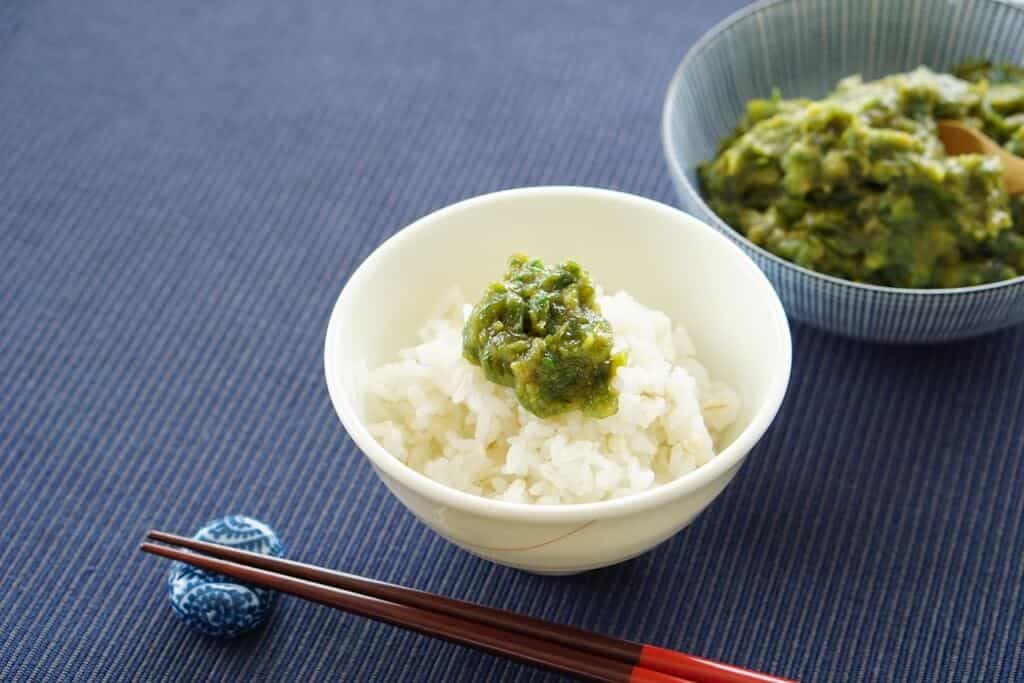



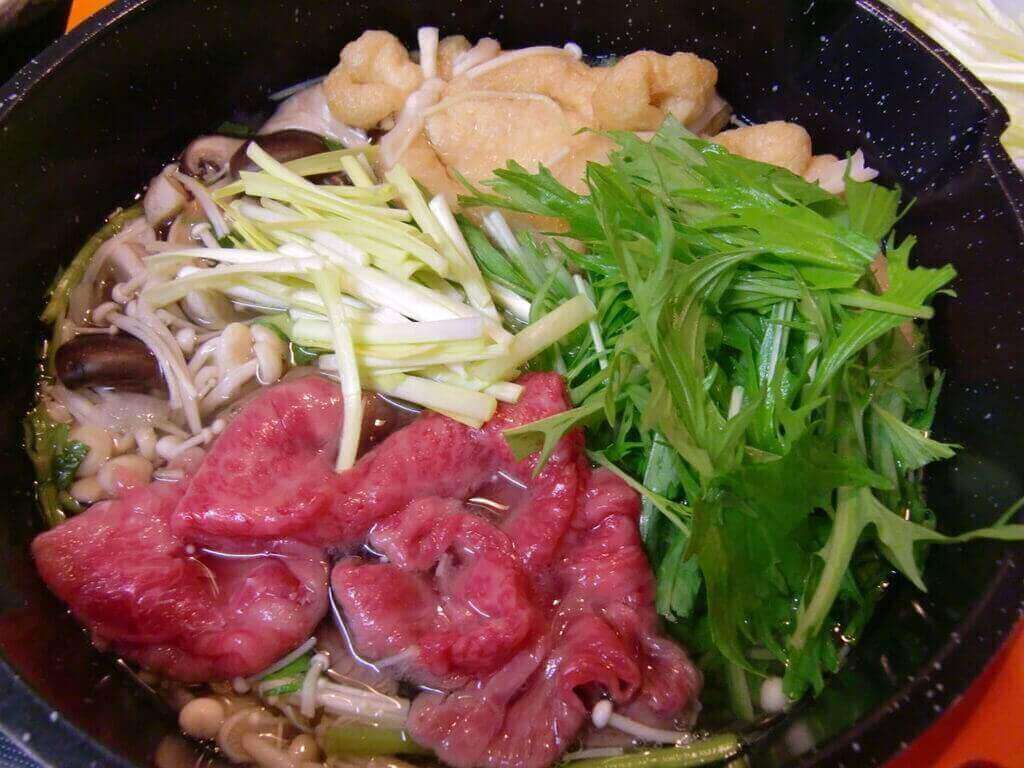



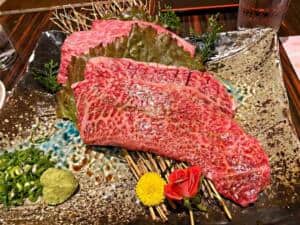


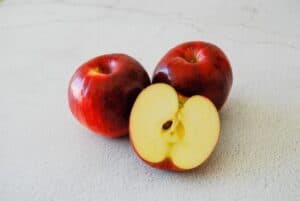


Comments